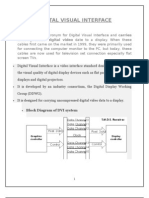0% found this document useful (0 votes)
44 views10 pagesDigital Visual Interface
Digital Visual Interface (DVI) is a video display interface developed to connect video sources to display devices, supporting both digital and analog signals through various connector types. It allows for high-resolution digital video transmission and has been widely adopted since its introduction in 1999, surpassing earlier standards like VGA. DVI connectors can be single or dual link, with dual link offering higher bandwidth and resolutions, and the interface is compatible with other standards through passive adapters.
Uploaded by
Lif AhadiCopyright
© © All Rights Reserved
We take content rights seriously. If you suspect this is your content, claim it here.
Available Formats
Download as PDF, TXT or read online on Scribd
0% found this document useful (0 votes)
44 views10 pagesDigital Visual Interface
Digital Visual Interface (DVI) is a video display interface developed to connect video sources to display devices, supporting both digital and analog signals through various connector types. It allows for high-resolution digital video transmission and has been widely adopted since its introduction in 1999, surpassing earlier standards like VGA. DVI connectors can be single or dual link, with dual link offering higher bandwidth and resolutions, and the interface is compatible with other standards through passive adapters.
Uploaded by
Lif AhadiCopyright
© © All Rights Reserved
We take content rights seriously. If you suspect this is your content, claim it here.
Available Formats
Download as PDF, TXT or read online on Scribd
/ 10




























































































